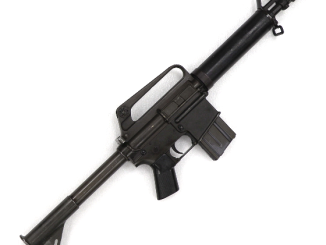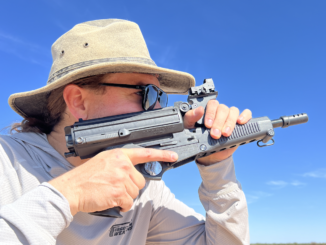How does full automatic effect a gun’s time on the PCC Cours of Fire? Well, let’s find out with a Lage Max31A Mk2 on a M-11A1. I’ve got a red dot optic on the gun to simplify aiming, and so the question is how semiauto compares to bursts.
My hypothesis was that automatic fire would offer no real benefit on this course, and I was correct. Despite giving myself 50% more ammunition than allowed for previous guns, I ran dry with 6 targets still left standing. The implications for the real world are not well represented here though, as real world targets are generally not static steel plates that react perfectly to a single hit. So the extra rounds in each burst are more likely to be useful in the real world than in this sort of target presentation. Later, I will repeat the test with the same gun, but set to semiauto only.




there’s a disconnect between target courses and real-world. I managed to shoot 100 % score with the M60 machine gun once–off the tripod, using the T&E. Within the time limits for the M60 course I could have fired a perfect score using the M16 series rifle–on semi-auto. Real-world conditions do give full-auto weapons advantages–sometimes–but that’s seldom reflected in match scores.
It`s naturally.
Such shooting is equivalent to trying to hit a small target with buckshot. The target is simply caught between hits.
In such a situation, automatic fire does not make sense, its purpose is completely different.
And to say that “automatic shooting makes weapons more lethal” can only be a clinical journalist who has seen a machine gun only on TV.
The idea that automatic shooting makes weapons effectively more lethal is utter BUNK if the user of said weapons can’t even hit the broad side of a barn with a single-shot rifle at 50 feet.
I will challenge both you, and Mr. S. above, to try to cross No-Man’s Land in 1916 and still say full-auto is somehow less lethal. No, that’s not fair, you wouldn’t likely be able to say anything again in this life. Mr. Cranford’s earlier comment about real-world conditions is most pertinent, as is Mr. Enzer’s comment below. In defense of journalists, they report on the real world, including wars, and many have seen MGs in action, sometimes at risk of their own lives.
Cool – a drama queen.
Okay, let’s don’t mix apples with oranges. No-Man’s land in 1916 is a case of machine guns being used to saturate a relatively dense population of targets, namely soldiers on the charge. The full-auto was effective because it was not one machine gun engaging a mob but multiple machine guns engaging a mob (the resulting barrage is something that Kirk can describe in better detail). The “journalists” that Mr. S disparages are the kind who don’t actually go to the battlefield but write articles based on second-hand opinions and rumors. Said people also tend to think that a machine gunner is little more than a rifleman on steroids, spraying everyone indiscriminately without stopping to reload or service his weapon.
“…they report on the real world…”(С)
Through the prism of his idea of ”how it could be”.
Exactly.
Just on the basis of such a “life experience”, then tales of “companies of German submachine gunners who fill everything with lead” appear.
And then, other, equally “competent” scribblers relay similar nonsense.
And since everyone is about the same nonsense, they have every reason to consider each other as experts on the issue. LOL
I have never run to a machine gun.
And my grandfather visited twice.
The first time, it was in the forest twilight, an assault dash to the machine-gun nest with DP27, from about 80 meters to zero. Of the entire squad, only one person was wounded in the neck.
The second time, in an open field, a distance of 800-1000 meters. The German machine gunner covered them together with a friend with several dozen shots.
All misses, though they both ended up in the hit spot.
The third time, probably, should have been fatal. Since almost everyone who had previously been driven up the slope to assault the machine-gun nests returned feet first.
He was saved by the fact that they did not have grenades with them.
While they were waiting for the delivery, the guys pulled up with a pair of light mortars and solved the situation.
I agree, in the real world some targets need more than one hit and some of those misses may have actually been helpful marginal hits.
If you could have some sort of fictional target set up where each required, say, 1-3 center of mass hits or one center and 1-3 anywhere before it fell (unknown to the shooter beforehand) it would be a bit more reflective of reality.
But yeah, on subgun courses semiauto is always faster, which is why most require full auto only. The hack is to use a gun that allows easy singles.
You’re not being evaluated on “hitting the target” with the M60 qual course so much as you’re being assessed as to how well you can use the tripod, T&E, and gun together with your AG as a team to deliver accurate MG fires. Sure, if you were to fire at those targets with an M16, you could likely take many of them down individually, but that’s not what the weapon is for, nor is that how you use it.
The US Army standard for the MG is delightfully low. As with the pistol, you can achieve “Expert” without having to do all that much, and it’s mostly an exercise in hitting the various qual range gates at the right time. Hell, TBH, I’m not really sure that the Army even has TrainFire ranges suitable for the MG anywhere but at Benning–Certainly, most of the ones I conducted MG training at over the years were so simplistic as to leave you with no way of even assessing what targets went down and why, other than the scorer/coach watching the silhouettes drop appropriately.
Automatic fire with an MG is a much different animal than what you do with a normal rifle–It’s an area/suppression weapon, not a point/target one.
You suppressed the hell out of the targets. Perhaps you needed a Hollywood drum magazine with 150 rounds in it.
“You suppressed the hell out of the targets.” 🙂
Obviously only going from 60 rounds to 100 rounds was poor judgement. That implies the ability to fire single rounds most of the time. You would need much better trigger control or a more realistic ammo supply.
Especially in case of automatic fire: you can either have not enough ammunition or not enough ammunition but unable to carry more.
My ex-Marine neighbor says that is why it needs a bayonet lug
Deceased good friend of mine was a Viet Nam vet who aggravated the everlasting piss out of me to get a bayonet for my semi-AR. He was almost overrun due to everyone running short of ammo in the Michelin Rubber Plantation over there and it left quite an impression on him. And yes, i got one- just to ease his mind if for no other reason.
Predictable but interesting none the less. Full auto in the real world has it’s place, but you need a lot of friends alongside you and a supply pipeline feeding you ammo to get the most out of it.
Need a course of fire that measure suppression – maybe something where hits within n3 feet of a target prevent it from shooting back at your for 5 seconds, or something like that. Talk to some people who have been fired upon with full auto.
Good idea. Also I feel the target size/ shape did not correspond to what you would shoot at in real engagement. Besides, did we talk of target movement? They are rarely stationary.
Still surprising that semi-auto pistol caliber carbines didn’t get serious consideration. I’ve read that the Reising was sort of meant for that role…
Didn’t get serious consideration when and from whom? After all, the M1 Carbine is chambered for what is essentially a pistol cartridge. Also, the WW1 “Artillery Luger” was basically a pistol caliber carbine with the shoulder stock attached and was used as such by German Stosstruppen.
“(…)semi-auto pistol caliber carbines didn’t get serious consideration(…)”
How do you define serious and why does Mayn carbine
http://sovietguns.blogspot.com/2014/02/mayn-762-mm-carbine.html
count?
is: “(…)count(…)”
should be: “(…)not count(…)”
The issue is that post WW2, the assault rifle was an up and coming concept that outperformed a PCC in most ways. More accurate, longer range, more power, and only moderately increased recoil (A 9mm blowback AR15 tends to kick just as hard if not harder than a 5.56 AR15). The only real benefit nowadays is commonality of ammo (same round between carbine and sidearm)
Ian, if you got a friendly SOT and wanted to try with a M3A1 let me know or any other projects.
You can say an “ideal range situation”, but revealing none-the-less. Ian was full of confidence at beginning, not as much at the end.
A reminder why I saw border guard semiauto rifle – SMG pairs. It makes more sense now.
Still, it made sense primarily because a semi-auto rifle chambered for a rifle cartridge had a much longer effective range than an SMG. Many NATO armies during the battle rifle era had mixed units with both battle rifles and SMGs, especially for armored/mechanized infantry. The firepower of the SMG for short range room and trench clearing could not be achieved with a battle rifle (whether semi-auto or select fire; the latter being far from controllable), but of course in many situations a more than 200 meters effective range was desirable.
Ian, you did a bad mistake at the end there. Showing that you normally shoot closed-bolt automatics. The manual of arms to clear and safe an open-bolt gun is the reverse: Take the magazine out, either leave the bolt forward or move the bolt forward cautiously and you are safe. when the bolt is locked to the rear an inserted magazine makes it ready to fire again and if the bolt catch does not hold as it is supposed to the gun goes bang or even rattatatatat. When the bolt is forward the spring pressure and the hopefully existant catches like on an Uzi keep anything from happening. In short: it is the reverse. Which freaks out inexperienced range officers all the time, because they insist of bolts being locked back. And chamberflags are a PITA with open-bolt guns.